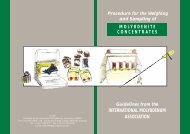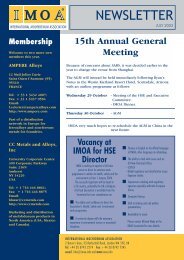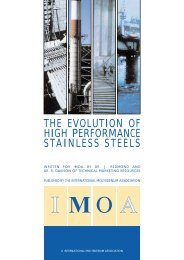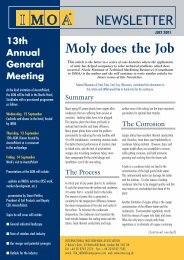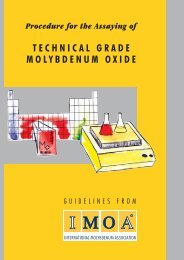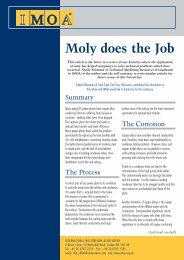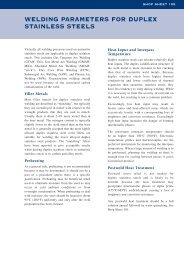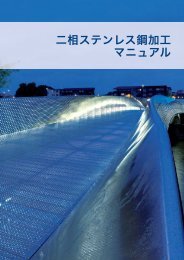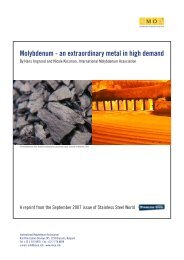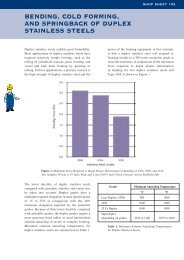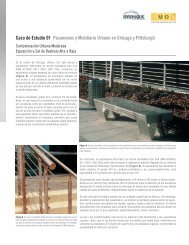2008 - IMOA
2008 - IMOA
2008 - IMOA
You also want an ePaper? Increase the reach of your titles
YUMPU automatically turns print PDFs into web optimized ePapers that Google loves.
INTERNATIONAL MOLYBDENUM ASSOCIATION<br />
R<br />
NEWSLETTER<br />
JANUARY <strong>2008</strong><br />
Membership<br />
Welcome to (in 2007):<br />
General Moly Inc is a molybdenum<br />
exploration and development company in the USA<br />
focused on the development of the Mt Hope and<br />
Hall-Tonopah moly deposits, located in Nevada.<br />
David J Joseph Co, a US company, brokers a<br />
complete line of ferro-alloys and specialty pig iron<br />
products. The group’s customers are steel mills and<br />
foundries.<br />
KTC Korea Co Ltd, a Korean company, trading<br />
molybdenum, with its own Kwangyang Ferroalloy<br />
Roasting Plant.<br />
Philips Advanced Metal Solutions, a Belgian<br />
company, is a specialist in the production of<br />
tungsten and molybdenum components for a wide<br />
range of applications and industries, including<br />
aerospace, automotive, health, electronics, music,<br />
nuclear and chemical industries.<br />
and in <strong>2008</strong>,<br />
19 t h Annual<br />
General<br />
Meeting<br />
Hosted generously and efficiently by<br />
Climax Molybdenum Company in the<br />
“mile high city” of Denver, 180 delegates<br />
were welcomed by David Thornton,<br />
President both of Climax and <strong>IMOA</strong>,<br />
beginning with dinner at The Fort (where<br />
the photos were taken).<br />
Thornton noted that Denver had the<br />
thinnest and fittest population in the<br />
USA, despite the largest number of<br />
microbreweries per capita and said that<br />
the next altitude test would face those<br />
100 delegates visiting the Henderson<br />
Mine which was two miles high.<br />
Addressing <strong>IMOA</strong>’s extensive work<br />
programme at the AGM the next day, he<br />
praised the work of the HSE Committee<br />
in providing a pool of data and<br />
information on moly to enable the<br />
industry to face the global challenges<br />
concerning moly exposure. Similarly, the<br />
Association’s market development<br />
programme continued to offer an<br />
education in the benefits and applications<br />
of moly, leading to increased demand.<br />
In the context of HSE, the Association’s<br />
initiative to form a Consortium to assist<br />
industry to implement REACH<br />
legislation which had come into force in<br />
June had not only attracted an immediate<br />
and positive response,but its progress was<br />
also ahead of most other metal industries.<br />
In general, Thornton remarked that<br />
membership had increased by 25% to<br />
70 companies in 2007 and that he was<br />
proud of the solidly structured and<br />
financed organisation which would<br />
remain when he retired as President.<br />
After thanking his fellow members on<br />
the Executive Committee, members of<br />
the HSE and MD Committees, all <strong>IMOA</strong><br />
members and staff for their support<br />
during his 2-year term of office,Thornton<br />
paid tribute to two long-serving members<br />
of the Executive Committee who were<br />
resigning.<br />
Galway Resources Ltd, a US Company, which<br />
is advancing the Victorio Molybdenum/ Tungsten<br />
project located in South-West New Mexico. The<br />
deposit contains over 200 million pounds of both<br />
Tungsten and Molybdenum.<br />
The <strong>IMOA</strong> website has<br />
been re-structured and<br />
readers are strongly<br />
recommended to renew<br />
their acquaintance with<br />
www.imoa.info<br />
Molybdenum is a part of life, being an essential<br />
trace element in humans, animals and plants,<br />
and a part also of our lives. Extensive information<br />
about “Moly’s” sources and markets, applications,<br />
benefits and characteristics is presented on this<br />
website.<br />
David Thornton (left), President of Climax<br />
Molybdenum and <strong>IMOA</strong> with Mario Vinageras,<br />
Vice-President Commercial of Southern Copper Corp<br />
Mark Smith (right), President of Chevron Mining,<br />
with Jack Goth, formerly Senior Executive Vice-<br />
President of Amax<br />
INTERNATIONAL MOLYBDENUM ASSOCIATION<br />
Rue Père Eudore Devroye 245, 1150 Brussels, Belgium<br />
Tel: +32 2 770 8878 Fax: + 32 2 770 8898 E-mail: info@imoa.info<br />
Web: www.imoa.info<br />
Dick De Cesare was retiring from<br />
Thompson Creek Metals and from the<br />
industry in which he had figured so<br />
prominently for 40 years. He was a key<br />
player behind the foundation of <strong>IMOA</strong><br />
although he did not join the Executive<br />
Committee until 1995. He served as<br />
President from 1998 through 2001 – for<br />
two terms, as the careful plans for<br />
succession failed for the first time – and<br />
his leadership and insights into the many<br />
challenges facing <strong>IMOA</strong> would be greatly<br />
missed.<br />
John Graell joined Molymet in 1983 and<br />
the Executive Committee in 1996,<br />
serving as President from (continued over)
2002 through 2005, again a two-term<br />
stint for the same reason. He initiated a<br />
Strategic Plan for <strong>IMOA</strong> – a two-day<br />
session for the Executive Committee in<br />
Boston conducted by MIT Professor<br />
Arnoldo Hax – which is regularly<br />
reviewed. Hopefully John would attend<br />
future AGMs from time to time in his<br />
continuing capacity as Executive<br />
President of Molymet.<br />
Lastly, Thornton expressed appreciation<br />
to Chevron Mining (formerly Molycorp)<br />
for offering to host a dinner at the<br />
Denver Art Museum.<br />
The quality of the following<br />
presentations and the magnetism of the<br />
speakers ensured a crowded meeting<br />
room at all times:<br />
● An Anecdotal History of Climax<br />
in Colorado” by Mr Jack Goth, formerly<br />
Senior Executive Vice-President of<br />
Amax.<br />
● Moly Market - an Update” by<br />
Mr Terry Adams, Managing Director,<br />
Adams Metals Ltd.<br />
Some Notes on<br />
the Henderson Mine<br />
The Henderson Mine is the largest primary moly mine in the world and is located in the Rocky Mountains,<br />
50 miles west of Denver. The construction project was a remarkable feat of engineering because the mill<br />
and tailing area were on different sides of the Continental Divide – the mine on the east and the mill fifteen<br />
miles away to the west (see photos). First a shaft had to be driven down 3,000ft below the surface on the<br />
east, then tunnels were dug from each direction,<br />
over a distance long enough to require that the<br />
earth’s curvature be taken into account, and a<br />
conveyor belt installed. Operations began in 1976<br />
and the mine has since produced more than 160<br />
million tonnes of ore and 770 million lbs of moly,<br />
according to its website.<br />
to West......<br />
Molybdenum REACH<br />
Consortium<br />
● Long Term Trends, Cycles, and<br />
Super Cycles in Metals Prices” by<br />
Dr John Cuddington, Coulter Professor<br />
of Mineral Economics at the Colorado<br />
School of Mines.<br />
● An Overview of Superalloy<br />
Compositions and Comparative Data<br />
and Examples of Applications” by<br />
Mr Lee Flower, Marketing Manager,<br />
Haynes International.<br />
HSE Issues, including plans for the<br />
REACH Consortium were addressed<br />
by Guido Provoost (Managing Director<br />
of Sadaci NV) and Sandra Carey with<br />
the HSE Team.<br />
The Market Development Session was<br />
led by Nicole Kinsman and focussed on<br />
Architecture, Desalination and<br />
Structural Uses of Stainless Steel.<br />
From East......<br />
And the Climax<br />
Mine …..<br />
Speculation that there were plans to reopen the<br />
famous Climax Mine in Leadville -located at a<br />
height marginally greater than Henderson and<br />
the first commercial supplier of moly back in 1918<br />
but last operated in 1995 - proved correct, when<br />
Freeport - McMoRan Copper and Gold, the owner<br />
of both the Henderson and Climax Mines, announced<br />
in December their intention to restart the open-pit<br />
mine and milling facilities in 2010.<br />
The Molybdenum REACH Consortium, initiated by<br />
<strong>IMOA</strong>, is up and running successfully and the first<br />
meetings took place in London on 19 December.<br />
There are currently 38 members (see the website –<br />
www.molybdenumconsortium.org<br />
for a complete list), with other companies expressing<br />
interest as the deadline was extended to 31 January<br />
<strong>2008</strong> and the minimum fee reduced to US$15,000.<br />
The Consortium Secretariat’s principal efforts in<br />
<strong>2008</strong> will be assisting members to pre-register;<br />
setting priorities for an extensive research programme<br />
of laboratory tests to generate the necessary data to<br />
conduct risk assessments on the substances covered<br />
by the Consortium Agreement; and organising Lead<br />
Registrants<br />
2<br />
Elections and Appointments:<br />
As President in <strong>2008</strong> and 2009<br />
Victor Pérez, Marketing Director of Codelco,<br />
in succession to David Thornton.<br />
To the Executive Committee:<br />
Duan Yuxian, Chairman, China Molybdenum Co Ltd<br />
Carlos Letelier, Operations Vice President,<br />
Molymet SA, in succession to John Graell<br />
Mark Wilson, Vice President of Sales and Marketing,<br />
Thompson Creek Metals Co, in succession to<br />
Richard De Cesare
Catherine Houska, <strong>IMOA</strong>'s consultant for stainless<br />
steel in architecture, building and construction (ABC)<br />
and Dr. Gary Carinci, <strong>IMOA</strong>'s consultant for stainless<br />
steel use in drinking water and desalination are<br />
reporting here on some recent developments in their<br />
work areas. With the help of Catherine and Gary,<br />
<strong>IMOA</strong> is providing decision makers with the<br />
information necessary to understand corrosion<br />
problems and to justify the use of higher<br />
performance Mo-containing stainless steels.<br />
Stainless Steel Helps Prevent<br />
Deicing Salt Corrosion.<br />
By Catherine Houska, TMR Stainless, Pittsburgh PA,<br />
consultant to <strong>IMOA</strong><br />
Road deicing salt has been used since<br />
the 1960’s to prevent commerce<br />
disruption and accidents in cities with<br />
regular winter snow (e.g. Düsseldorf<br />
and Chicago) or freezing rain exposure<br />
(e.g. Beijing or Dallas). Total deicing<br />
salt tonnage has continued to increase<br />
worldwide and corrosion damage is not<br />
limited to highways and vehicles.<br />
Building material corrosion and<br />
premature failure is a significant<br />
and growing problem.<br />
Road salt mists are formed as the tires<br />
of moving vehicles spray tiny particles<br />
of salt water or dry salt particles into<br />
the air. Hundreds of deicing salt<br />
studies have been done but most<br />
focused on areas close to roadways.<br />
New US research has documented<br />
seasonal deicing salt accumulations as<br />
much as 1.9 km (1.2 miles) downwind<br />
of a major highway outside of Chicago.<br />
The researchers collected data between<br />
1997 and 2004 and produced a model<br />
(Figure 1) covering a 5 x 5-km (3.1 x 3.1-mi) area. 1<br />
It shows that sites within 100 m (328 ft) of busy<br />
roadways can be comparable to moderate to severe<br />
coastal areas.<br />
The researchers theorized that urban areas with busy<br />
roadways might have regional deicing salt plumes or<br />
mists for several days after a snow event.<br />
This increases total salt accumulation on buildings.<br />
In Chicago, deicing salt-related metal corrosion has been<br />
found up to the 60th floor of one tall building. 2 Exposure<br />
levels are likely to be similar in any major city with<br />
regular winter snow exposure.<br />
Figure 1: Model projection of annual deicing salt deposition around highways I-55 and I-355<br />
and small surface roads with the spacing of some test sites shown. Illinois Department of<br />
Transportation (DOT) in collaboration with Argonne National Laboratory (ANL) and the U.S.<br />
National Atmospheric Deposition Program/National Trends Network (NADP/NTN)<br />
Internationally, it is estimated that over 60 million<br />
metric tons (66 million tons) of salt are used for<br />
deicing. 3 China, which previously used very little<br />
deicing salt, has had a considerable increase in usage and<br />
recently became the world’s largest producer.<br />
In the US, about 70% of the roads and population areas<br />
receive at least 13 cm (5 inches) of snow annually and<br />
additional areas are affected by seasonal freezing rain. In<br />
recent years, the United States used 13.6 to 18 million<br />
metric tons (15 to 20 million tons) of deicing salt per<br />
year and Canada used another 3.6 to 4.5 million metric<br />
tons (4 to 5 million tons). 4 3
Table 1:<br />
Road and bridge snow and ice control procedures in countries that participated in a 2002<br />
Country Deicing Products Used Tons (1,000) Deicing Period<br />
Austria NaCl, CaCl 2 NA Nov. - March<br />
Belgium NaCl, CaCl 2 113 Oct. - April<br />
Croatia NaCl NA NA<br />
Czech Republic NaCl, CaCl 2 , MgCl 2 215 Nov. - April<br />
Denmark NaCl 115 Oct. - April<br />
Finland NaCl NA Oct. - April<br />
France NaCl, CaCl 2 400 – 1,400 Nov. - March<br />
Germany NaCl, CaCl 2 , MgCl 2 2,000 Nov. - March<br />
Great Britain NaCl, CaCl 2 2,200<br />
Hungary NaCl, CaCl 2 NA Nov. - March<br />
Iceland NaCl, CaCl 2 NA Oct. - April<br />
Ireland NaCl 30 - 70 Nov. - April<br />
Norway NaCl 83 Oct. - April<br />
Poland No details NA NA<br />
Romania NaCl 108 Nov. - March<br />
Slovenia NaCl, CaCl 2 , MgCl 2 NA NA<br />
Spain NaCl, CaCl 2 80 Oct. - April<br />
Sweden NaCl 300 Oct. - April<br />
Switzerland NaCl, CaCl 2 NA Oct. - April<br />
The Netherlands NaCl, CaCl 2 135 Oct. - April<br />
NA – total tonnage data not available<br />
The most comprehensive European<br />
study was done in 2002 when<br />
twenty countries participated in a<br />
task group that studied deicing<br />
practices. Table 1 summarizes the<br />
deicing methods used in each<br />
country, and, where available, the<br />
annual tonnage. It is evident from<br />
this and other data sources that<br />
deicing is standard practice<br />
throughout Europe.<br />
Unfortunately, many designers are<br />
not aware that deicing salt is very<br />
corrosive to architectural materials,<br />
and inadequate knowledge can lead<br />
to inappropriate material selection<br />
and premature failure. Molybdenumcontaining<br />
stainless steels are often a<br />
cost-effective choice when long-term<br />
performance, aesthetics, security,<br />
and/or minimal maintenance are<br />
important because the molybdenum<br />
alloying addition improves resistance<br />
to chloride (salt) corrosion.<br />
European study of Winter maintenance practices 3 Figure 2:<br />
4<br />
Many Europeans incorrectly assume that their deicing<br />
salt use is quite minimal, but it is actually similar to<br />
North American use. Deicing salt tonnage is increasing<br />
in both regions. For example, the salt industry<br />
association, Verband der Kali- und Salzindustrie e.V.,<br />
reported that over 3 million metric tons of deicing salt<br />
were used on German roads during both 2005 and 2006,<br />
which is a 50% increase since 2002. 5<br />
Type 316 stainless steel (with 2% molybdenum) with a<br />
smooth finish is preferred for many applications exposed<br />
to deicing salt. In applications with very high salt<br />
exposure levels (i.e. embedded sidewalk lighting and<br />
entrance gratings) and areas regularly exposed to salt<br />
water splashing, a more corrosion resistant stainless steel<br />
or regular cleaning may be necessary. Stainless steels<br />
with higher molybdenum contents, like Types 2205,<br />
317LMN, and 904L, are generally sufficient for these<br />
seasonal high deicing salt exposure<br />
applications.<br />
The Frederick R<br />
Weisman Art Museum<br />
has a smooth No. 4<br />
finish on its Type 316<br />
stainless steel exterior<br />
and is easily<br />
rain-washed. Despite<br />
five-year gaps between<br />
cleanings, no corrosion<br />
staining is evident but<br />
there is some dirt<br />
accumulation.<br />
photo: Nickel Institute<br />
The Type 316 stainless steel exterior of<br />
Frank Gehry’s Weisman Art Museum<br />
(Figure 2) illustrates that success is<br />
readily achievable when an appropriate<br />
stainless steel is selected, while<br />
Figure 3 shows unacceptable staining<br />
on a Type 304 stainless steel panel with<br />
less significant deicing salt exposure.
Figure 3:<br />
This Type 304 panel is<br />
on the second floor of a<br />
building in downtown<br />
Pittsburgh. Although it is<br />
cleaned more frequently<br />
than the building in<br />
Figure 2, it is exhibiting<br />
significant deicing salt<br />
corrosion staining.<br />
Photo: Catherine Houska<br />
steel selection and the relative performance of<br />
competitive architectural metals.<br />
For example, there is a common misconception among<br />
architects that aluminum’s corrosion resistance is<br />
similar to that of stainless steel. This is incorrect. In<br />
locations that are exposed to chlorides (coastal or deicing<br />
salt), the corrosion rate of aluminum is typically 10 to<br />
100 times that of stainless steel. The white to grayish<br />
white color of aluminum corrosion product may not<br />
bring attention to the problem (as the rusting red of steel<br />
does), until permanent aesthetic or structural damage<br />
has been done. This lack of knowledge makes<br />
aluminum a common replacement for stainless steel<br />
when construction costs must be reduced. Figures 4<br />
and 5 show severe aluminum corrosion in a deicing salt<br />
laden environment and provide a significant contrast to<br />
Figure 2.<br />
Figure 4:<br />
Severe deicing salt corrosion has caused perforation of this aluminum<br />
door threshold. Photo: Catherine Houska<br />
International “sustainable” design trends have made the<br />
specification of long lasting materials even more<br />
important. Most of the world’s major population<br />
centers are exposed to coastal or deicing salt or both.<br />
<strong>IMOA</strong> has developed and posted a new web article on the<br />
international impact of deicing salt (see www.imoa.info).<br />
It contains the information shared in this article as well<br />
as a more in-depth discussion of the relative<br />
performance of competitive materials. <strong>IMOA</strong> is<br />
providing decision makers with the information<br />
necessary to understand the problem and justify the use<br />
of high performance Mo-containing stainless steels.<br />
Notes<br />
1. Allen L. Williams and Gary J. Stensland, “Atmospheric Dispersion Study of<br />
Deicing Salt Applied to Roads,” Part II Final Report For Period July 2002 to June<br />
2004, in the January 2006 issue of Physical Research Report No. 140, Illinois<br />
Department of Transportation.<br />
Figure 5:<br />
Deicing salt corrosion of charcoal grey anodized<br />
aluminum panels on the second floor of an office building lead to<br />
permanent surface damage. Photo:Catherine Houska<br />
To avoid problems, specifiers must be made aware of the<br />
severity of the deicing salt problem, comparative metal<br />
corrosion rates, and common deicing myths. This makes<br />
it necessary to provide information on both stainless<br />
2. Catherine Houska, “Which Stainless Steel Should Be Specified for Exterior<br />
Applications?”, International Molybdenum Association, architecture, building and<br />
construction series<br />
3. European Task Force TG3, ‘Snow and Ice Control on European Roads and<br />
Bridges’, August 2002<br />
4. Salt Institute, www.saltinstitute.org.<br />
5. The European Salt Company, www.esco-salt.com<br />
5
Molybdenum-Bearing<br />
Duplex Stainless Steel –<br />
The Optimal Material for Desalination<br />
By Dr. Gary Carinci, TMR Stainless, Pittsburgh PA, consultant to <strong>IMOA</strong><br />
Introduction<br />
Water is the most abundant resource on Earth and all<br />
life depends on it; however, only one percent of it is<br />
available as freshwater. This amount is unevenly<br />
distributed, and many arid areas such as the Middle<br />
East suffer from alarming shortages where a liter of<br />
drinking water is more costly than a liter of gasoline.<br />
Desalination is one of the main ways to solve water<br />
shortages where energy is readily available. The global<br />
water desalination market has been growing at a<br />
compound average rate of 12% a year for the past five<br />
years, according to Desalination Markets, published by<br />
Global Water Intelligence. With massive projects such<br />
as the 800,000 m 3 /day independent water and power<br />
plant at Jubail Industrial City in Saudi Arabia still to<br />
come, there are no signs that the market is slowing<br />
down.<br />
Desalination is a process in which dissolved minerals<br />
including salt are removed from seawater, brackish<br />
water, or treated wastewater. The major technologies<br />
available for desalination include distillation and<br />
membrane technologies. Distillation is a thermal process<br />
in which feed water is heated and then evaporated to<br />
separate out dissolved minerals. The most common<br />
methods of distillation include multistage flash (MSF)<br />
and multiple effect distillation (MED). In membrane<br />
processes such as reverse osmosis, feed water is pumped<br />
at high pressure through permeable membranes, which<br />
separate the salts from the water.<br />
Today the Middle East is the main region where<br />
desalination is widely used, with more than half of the<br />
total world capacity. Most of the region is below the<br />
level of adequate freshwater supplies as defined by the<br />
World Health Organization, and the United Arab<br />
Emirates, Kuwait, Bahrain and Qatar depend solely on<br />
desalination for freshwater. Saudi Arabia is now the<br />
world’s largest producer of desalinated water with<br />
desalination meeting 70% of the country’s present<br />
drinking water needs and with major urban and<br />
industrial centers supplied through a network of water<br />
pipes that run for more than 3,700 kilometers. Several<br />
new desalination plants are planned, or under<br />
construction, which will ultimately bring the total to<br />
approximately 40 such facilities.<br />
Multistage Flash<br />
Distillation<br />
Distillation technologies which use natural gas or oil<br />
fired boiler units are typical in the Middle East because<br />
of the low cost of energy in the region. These<br />
technologies involve highly corrosive operating<br />
environments because of the high salinity and elevated<br />
operating temperatures. In multistage flash distillation<br />
plants, heated seawater boils rapidly (flash) when the<br />
pressure of the vapor is reduced rapidly below the vapor<br />
pressure of the liquid at that temperature. Part of this<br />
brine flashes into vapor and is condensed on an<br />
overhead tube bundle, forming distilled water.<br />
The water is collected in a trough mounted below the<br />
tube bundle and forms the end product fresh water<br />
(Figure 1).<br />
Multiple Effect<br />
Distillation<br />
Multiple effect distillation plants use horizontal tube<br />
bundles, where steam is condensed on one side of a<br />
tube with heat transfer causing evaporation of seawater<br />
on the other side. Steam introduced into the first,<br />
highest temperature effect is condensed inside the tubes,<br />
and the heat thereby released causes a nearly equal<br />
amount of vapor to be evaporated from the feed water<br />
on the outside of the tubes. The vapor produced in the<br />
SEAWATER<br />
BRINE<br />
BRINE TEMPERATURE<br />
=110 0 C<br />
FRESH<br />
WATER<br />
6<br />
Figure 1. Typical flow diagram of MSF process where the water is pre-heated in each stage and evaporation takes place in<br />
each stage due to vacuum pressure in each flash chamber.
SEAWATER<br />
SPRAY,<br />
FALLING FILM<br />
THE STEAM IS CONDENSED IN NEXT STAGE<br />
TOP BRINE<br />
TEMPERATURE<br />
60-70 0 C<br />
BRINE<br />
Figure 2. Typical flow diagram of MED process where the evaporation occurs by heat transfer between<br />
condensing vapor on one side and evaporating brine on the other side of the heat exchanger tubes.<br />
FRESH WATER<br />
first effect is, in turn, condensed in the second effect,<br />
again evaporating a portion of the brine feed water.<br />
“Multiple effect” distillation uses more than one boiling<br />
chamber or “effect” to produce distilled water<br />
(Figure 2)). The lower brine temperatures in this<br />
process, compared with the MSF process, result in a less<br />
corrosive environment and lower alloyed stainless steels<br />
can be used in the construction of MED evaporators.<br />
With multiple effect technology, the heat energy<br />
contained in the steam generated in the first<br />
boiling chamber is reused to boil more water in<br />
subsequent boiling chambers. This recycling of energy<br />
provides the energy saving feature of multiple effect<br />
distillation, which has made this technology an ideal<br />
solution for addressing the normally large energy<br />
consumption required for desalinating seawater.<br />
stainless steel or dual duplex construction using 2205<br />
stainless steel in combination with a lean duplex<br />
stainless steel for lower temperature MED evaporators.<br />
By utilizing the higher mechanical properties of duplex<br />
stainless steel, the thickness and weight of the<br />
evaporator vessel can in many cases be reduced by as<br />
much as 30% compared to austenitic stainless steel or<br />
carbon steel construction. Duplex stainless steel<br />
evaporators, require less material, less welding and can<br />
therefore, be built at lower cost than alternate corrosion<br />
resistant materials (Figure 3). Further benefits of<br />
lightweight construction with duplex stainless steel<br />
include easier handling and lower environmental impact.<br />
With the global desalination capacity growth<br />
predicted at 14% per year and 25 million m 3 /day<br />
growth forecasted for the Persian Gulf desalination<br />
market through 2015 (Global Water Intelligence), this<br />
development in the Gulf alone will require approximately<br />
275,000 metric tons of duplex stainless steel. Assuming<br />
all the evaporator construction is completed using 2205<br />
duplex stainless steel, over 9,000 metric tons of<br />
molybdenum will be required for the Persian Gulf<br />
desalination projects. The thermal desalination<br />
expansion in the Middle East using MED and MSF<br />
technologies will provide an important market for<br />
molybdenum-bearing duplex stainless steels.<br />
Figure 3: As-fabricated duplex stainless steel<br />
evaporator (Abu Dhabi, UAE)<br />
Materials<br />
The earliest thermal desalination plants were built using<br />
mild steel, but corrosion was a significant problem and<br />
later evaporators were built using carbon steel clad with<br />
316L (UNS S31603) stainless steel. Lately duplex<br />
stainless steels such as 2205 (UNS S32205) and lean<br />
duplex stainless steels have emerged as the optimal<br />
grades for desalination plants because of their high<br />
corrosion resistance and mechanical strength<br />
(Table 1). Many recent evaporators in the Middle<br />
East have been constructed using either 2205 duplex<br />
Grade UNS EN C (max) Cr Ni M o N Yield, min (MPa) Tensile, min (MPa)<br />
316L S31603 1.4404 0.03 17 11 2 . 1 170 485<br />
2205 S32205 1.4462 0.03 22 5 3 . 3 0.16 450 655<br />
Table 1: Stainless steels used in thermal desalination plants (nominal composition<br />
in weight %, balance iron)<br />
7
INTERNATIONAL MOLYBDENUM ASSOCIATION<br />
R<br />
LIST of MEMBERS<br />
Secretary-General: Michael Maby. Technical Director: Nicole Kinsman,<br />
HSE Executive: Sandra Carey.<br />
AUSTRALIA<br />
Moly Mines Ltd<br />
46-50 Kings Park Road, West Perth, WA 6005, AUSTRALIA<br />
Tel: +61 8 9429 3300; Fax: +61 8 9429 3399<br />
Email: info@molymines.com Website: www.molymines.com<br />
AUSTRIA<br />
Interalloys Trading & Business ConsultingGmbH<br />
Floragasse 7, A1040 Vienna, AUSTRIA<br />
Tel: +43 1 504 6138; Fax: +43 1 504 6192<br />
Email: interal@ycn.com<br />
Plansee SE<br />
6600 Reutte, AUSTRIA<br />
Tel: +43 5672 6000; Fax: +43 5672 600 500<br />
Email: info@plansee.com Website: www.plansee.com<br />
Treibacher Industrie AG<br />
Auer-von-Welsbach, Strasse 1,9330 Althofen, AUSTRIA<br />
Tel: +43 4262 505; Fax: +43 4262 505 8416<br />
Email: ferdinand.kampl@treibacher.com<br />
Website: www.treibacher.com<br />
BELGIUM<br />
Philips Advanced Metal Solutions<br />
Steenweg op Gierle 417, B-2300 Turnhouot, BELGIUM<br />
Tel: +32 14 401 288; Fax: +32 14 401 658<br />
Email: jacky.boonen@philips.com Website: Philips.com/ams<br />
Sadaci NV<br />
Langerbruggekaai 13, B9000 Gent, BELGIUM.<br />
Tel: +32 92 540 511; Fax: +32 92 540 571<br />
Email: daisy.sergeant@sadaci.be Website: www.sadaci.be<br />
CANADA<br />
Oriental Minerals Inc<br />
24thFloor,1111 West Georgia Street, Vancouver, BC, V6E 4M3,<br />
CANADA<br />
Tel: +1 604 681 5755; Fax: +1 604 684 2990<br />
Email: info@orientalminerals.com<br />
Website: www.orientalminerals.com<br />
CHILE<br />
Codelco Chile<br />
Huerfanos 1270, Santiago, CHILE<br />
Tel: +56 2 690 3406; Fax: +56 2 690 3366<br />
Email: vperez@codelco.cl Website: www.codelco.cl<br />
Estudios Antofagasta Copper Ltda<br />
Ahumada 11, Oficina 613, Santiago, CHILE<br />
Tel: +56 2 377 5000; Fax: +56 2 377 5096<br />
Email: gsanchez@aminerals.cl<br />
Website: www.antofagasta.co.uk<br />
Molibdenos y Metales SA<br />
Huerfanos 812, 6th Floor, Santiago, CHILE<br />
Tel: +56 2 368 3600; Fax: +56 2 368 3653<br />
Email: info@molymet.cl; Website: www.molymet.cl<br />
CHINA<br />
Chaoyang Jinda Molybdenum Co Ltd<br />
No 788 Section 4, Longshan Street, Chaoyang, Liaoning,<br />
122000, CHINA<br />
Tel:+86 421 297 6888; Fax:+86 421 297 6666<br />
Email: jindamolybdenum@163.com<br />
Website: www.jindamoly.com<br />
China Molybdenum Co Ltd<br />
374 Junshan West Road, Luanchuan County, Luoyang, Henan<br />
471500, CHINA<br />
Tel:+86 379 6681 9855;Fax:+86 379 6681 9885<br />
Email: liuyh@chinamoly.com<br />
Website: http://www.chinamoly.com<br />
Grand Build Metal International Co Ltd<br />
1002B East Ocean Centre, 98 Granville Road,<br />
Kowloon, Hong Kong, CHINA<br />
Tel: +852 3542 5659; Fax: +852 3542 5655<br />
Email: grandbuild@grandbuild.com.hk<br />
Huludao Hongda Moly Co Ltd<br />
9 Haifei Road, Qibu District, Longgang Development Zone,<br />
Huludao, Liaoning, CHINA<br />
Tel:+86 429 858 6666; Fax:+86 429 213 9888<br />
Email: dreamliang@263.net Website: www.hongdamoly.com<br />
Jiangsu Fengfeng Tungsten and Molybdenum<br />
Materials Co Ltd<br />
Tang Jia Se, The Northern Suburbs of Dongtai,<br />
Jiangsu 224200, CHINA<br />
Tel:+86 515 527 3311; Fax:+86 515 527 1237<br />
Email: djppaa@126.com; Website: www.fengfeng.com.cn<br />
Jinduicheng Molybdenum Co Ltd<br />
17th Floor,Jie Rui Mansion,5 West section of the 2nd South<br />
Ring Road, Xian, Shaanxi 710068, CHINA<br />
Tel:+86 29 8837 8676; Fax: +86 29 8837 8771<br />
Email: jck@jdc.com.cn; Website: www.jdcmmc.com<br />
DENMARK<br />
Haldor Topsoe A/S<br />
Nymoellevej 55, DK-2800 Lyngby, DENMARK<br />
Tel: +45 4527 2000; Fax: +45 4527 2999<br />
Email:catalyst@topsoe.dk Website: www.topsoe.com<br />
FRANCE<br />
Ampere Alloys<br />
12 Mail Joliot Curie,Saint Ouen L’Aumone (95),95310 FRANCE<br />
Tel: +33 1 34 32 4007; Fax: +33 1 30 37 0584<br />
Email: f.celerier@amperealloys.com<br />
Arcelor Mittal Purchasing<br />
5 Rue Luigi Cherubini,93212 La Plaine Saint-Denis Cedex,<br />
FRANCE<br />
Tel: +32 2 533 3613; Fax: +32 2 533 3601<br />
Email: carl.landuydt@purchasing.arcelor.com<br />
Website: www.arcelor.com<br />
GERMANY<br />
CM ChemieMetall GmbH Bitterfeld<br />
ChemiePark Bitterfeld-Wolfen, Areal E,<br />
Niels-Bohr-Straße 5,D-06749 Bitterfeld, GERMANY<br />
Tel:+49 3493 604 000; Fax:+49 3493 604 001<br />
Email: info@chemiemetall.de<br />
Website: www.chemiemetall.de<br />
GfM Fesil GmbH<br />
Schifferstrasse 200, D-47059 Duisburg, GERMANY<br />
Tel:+49 203 300 070; Fax:+49 203 3000 7110<br />
Email:info@gfm-fesil.de Website:www.gfm-fesil.de<br />
Grondmet Metall-und Rohstoffvertriebs GmbH<br />
Luegallee55,40545 Düsseldorf Oberkassel,GERMANY<br />
Tel: +49 211 577 250; Fax: +49 211 577 2555<br />
Email:info@grondmet.de Website: www.grondmet.de<br />
FW Hempel Metallurgical GmbH<br />
Leopoldstr. 16, D40211 Düsseldorf, GERMANY<br />
Tel: +49 211 168 060; Fax: +49 211 168 0648<br />
Email:info@metallurgical.de Website:www.metallurgical.de<br />
Metherma GmbH<br />
Arnheimer Str. 103, D40489 Düsseldorf, GERMANY<br />
Tel: +49 211 40 80 840; Fax: +49 211 40 71 26<br />
Email: molybdenum@metherma.de<br />
HC Starck GmbH<br />
Im Schleeke 78 91, D38642 Goslar, GERMANY<br />
Tel: +49 5321 7510; Fax: +49 5321 751 6192<br />
Email: info@hcstarck.com Website: www.hcstarck.com<br />
IRAN<br />
Pars Molybden Co<br />
No 46 Bahar Alley, South Shiraz St<br />
Molla Sadra Ave, 14358 Tehran, IRAN<br />
Tel: +98 21 806 3917; Fax: +98 21 806 1476<br />
Email: info@parsmolybden.com<br />
ISRAEL<br />
Commodity Resources Inc<br />
Dor Dor V’Dorshav 4, Jerusalem 93117, ISRAEL<br />
Tel: +972 2 561 0658; Fax: +972 2 561 0660<br />
Email: jdm@attglobal.net<br />
Metal-Tech Ltd<br />
Ramat Hovav, PO Box 2412, Beer-Sheva 84874, ISRAEL<br />
Tel: +972 8 657 2333; Fax: +972 8 657 2334<br />
Email:general@metal-tech.co.il Website: www.metal-tech.co.il<br />
KOREA<br />
KTC Korea Co Ltd<br />
KTC Youngsang Building 567-49, Yeonnam-Dong,<br />
Mapo-Gu, Seoul, KOREA<br />
Tel: +82 2 2068 6555; Fax: +82 2 2068 7076<br />
Email: moly@ktckorea.com Website: www.ktckorea.com<br />
JAPAN<br />
Kohsei Co Ltd<br />
Kohsei Building, 2-11 Kobunacho Nihonbashi Chuoku,<br />
103-0024 Tokyo, JAPAN<br />
Tel: +81 3 5652 0901; Fax: +81 3 5652 0905<br />
Email: itibu@kohsei.co.jp Website: www.kohsei.co.jp<br />
Mitsubishi Corp<br />
16-3 Konan 2-chome, Minato-ku, Tokyo 108-8228, JAPAN<br />
Tel: +81 3 6405 3273; Fax: +81 3 64058871<br />
Email: yuji.fukumoto@mitsubishicorp.com<br />
Website: www.mitsubishicorp.com<br />
Sojitz Corp<br />
Ferroalloys Section 1,Iron Ore and Ferroalloys Dept<br />
1-20 Akasaka 6-chome, Minato-ku,Tokyo 107-8655,JAPAN<br />
Tel: +81 3 5520 3529; Fax: +81 3 5520 3517<br />
Email: matsumura.hiroshi@sojitz.com<br />
Website: www.sojitz.com<br />
Taiyo Koko Co Ltd<br />
31, 3chome Marunouchi, Chiyodaku,Tokyo 1000005, JAPAN<br />
Tel: +81 3 3216 6041; Fax: +81 3 3216 6045<br />
Email: trade@taiyokoko.co.jp<br />
KAZAKHSTAN<br />
Dala Mining LLC<br />
050043, Koshek Batyr, 5, Almaty, KAZAKHSTAN<br />
Tel: +7 327 226 6820; Fax: +7 327 226 6823<br />
Email: info@dalamining.kz<br />
LUXEMBOURG<br />
Traxys Europe SA<br />
3 rue Pletzer,Centre Helfent, L-8080 Bertrange,LUXEBOURG<br />
Tel: +352 45 99 991; Fax: +352 45 999 9223<br />
Email: heinz.duechting@traxys.com<br />
MEXICO<br />
Mexicana de Cobre SA de CV<br />
Av Baja California 200, Col. Roma Sur,<br />
06760 Mexico DF, MEXICO<br />
Tel: +52 555 264 7775; Fax: +52 555 264 7769<br />
Email: archibaldo.deneken@mm.gmexico.com<br />
Website: www.gmexico.com<br />
Molymex SA de CV<br />
Tehuantepec No 90 Col. Centenario,<br />
Hermosillo, Sonora 83260, MEXICO<br />
Tel: +52 662 289 3640; Fax: +52 662 289 3650<br />
Email: administracion@molymex.com.mx<br />
Website: www.molymex.com.mx<br />
PERU<br />
Southern Copper Corporation<br />
Av Caminos del Inca 171<br />
Chacarilla del Estanque, Surco, Lima 33, PERU<br />
Tel: +51 1 512 3330; Fax: + 51 1 217 1351<br />
Email: jdlheros@southernperu.com.pe<br />
Website: www.southernperu.com<br />
RUSSIA<br />
Baltic Enterprise Ltd<br />
40,The 17th Line,VO,Saint-Petersburg, 199178, RUSSIA<br />
Tel: +7 812 325 8688; Fax: +7 812 325 8687<br />
Email: bm@soli.ru Website: www.soli.ru<br />
JSC Polema Corp<br />
Przhevalskogo Str 3, Tula, 300016, RUSSIA<br />
Tel: +7 095 633 1177; Fax: +7 095 633 1527<br />
Email: polema@metholding.com Website: www.polema.ru<br />
SWEDEN<br />
AB Ferrolegeringar<br />
PO Box 71 63, Sveavägen 9, 103 88 Stockholm, SWEDEN<br />
Tel: +46 8 454 6560; Fax: +46 8 796 0636<br />
Email: info@ferrolegeringar.se<br />
Website: www.ferrolegeringar.se<br />
Outokumpu Stainless AB<br />
PO Box 74, S-774 22 Avesta, SWEDEN<br />
Tel: +46 226 810 00; Fax: +46 226 813 05<br />
Email: info.stainless@outokumpu.com<br />
Scandinavian Steel AB<br />
Birger Jarlsgatan 15, SE 111 45 Stockholm, SWEDEN<br />
Tel: +46 8 614 2850; Fax: +46 8 611 6434<br />
Email: metals@scandinaviansteel.se<br />
SWITZERLAND<br />
Cronimet Suisse AG<br />
Allmendstrasse 11, CH-6312 Steinhausen, SWITZERLAND<br />
Tel: +41 41 748 5040; Fax: +41 41 748 4201<br />
Email: tendoornkatt.fritz@cronimet.ch<br />
Glencore International AG<br />
Baarermattstrasse 3, CH-6341 Baar, SWITZERLAND<br />
Tel: +41 41 709 2000; Fax: + +41 41 709 3000<br />
Email: info@glencore.com Website: www.glencore.com<br />
UK<br />
Adams Metals Ltd<br />
1 Milkhouse Gate, Guildford, Surrey, GU1 3EZ,UK<br />
Tel: +44 1483 577 900; Fax: +44 1483 578 008<br />
Toll Free: +1 800 473 8427; Fax: +1 800 473 8428<br />
Email: info@adamsmetals.com<br />
Website: www.adamsmetals.com<br />
Alfred H Knight International Ltd<br />
Eccleston Grange, Prescot Road, St Helens,<br />
Merseyside WA10 3BQ, UK<br />
Tel: +44 1744 733757; Fax: +44 1744 27062<br />
Email:enquiries@ahkgroup.com<br />
Website: www.ahkgroup.com<br />
Derek Raphael & Co Ltd<br />
8-10 Castle Street, Cirencester, Gloucestershire GL7 1QA, UK<br />
Tel: +44 1285 885 821; Fax: +44 20 7504 8483<br />
Email: araphael@derek-raphael.co.uk<br />
Website: www.derek-raphael.co.uk<br />
Alex Stewart (Assayers) Ltd<br />
Caddick Rd,Knowsley Industrial Estate,Merseyside L34 9ER, UK<br />
Tel: +44 151 548 7777; Fax: +44 151 548 0714<br />
Email: enquiries@alexstewart.com<br />
Website: www.alexstewart.com<br />
Wogen Resources Ltd<br />
4 The Sanctuary, Westminster, London,SW1P 3JS, UK<br />
Tel: +44 20 7222 2171; Fax: +44 20 7222 5862<br />
Email: Allan.kerr@wogen.com Website: www.wogen.com<br />
Wyseway (UK) Ltd<br />
Power Road Studios,114 Power Road,<br />
Chiswick, London W4 5PY, UK<br />
Tel: +44 20 8742 3420; Fax: +44 20 8742 3421<br />
Email: mail@wyseway.co.uk<br />
USA<br />
Albemarle Corp<br />
451 Florida Street, Baton Rouge, LA 70801, USA<br />
Tel: +1 225 388 8042; Fax: +1225 388 7686<br />
Email: chris_knight@albemarle.com<br />
Website: www.albemarle.com<br />
Barex Resources Inc<br />
105B Van Houten Avenue, Passaic Park,NJ 07055-5518, USA<br />
Tel: +1 973 778 6470; Fax: +1 413 460 7930<br />
Email: nrs@barexresources.com<br />
Bear Metallurgical Co<br />
679 East Butler Road, Butler, PA 16002, USA<br />
Tel: +1 724 283 6800; Fax: +1 724 283 6078<br />
Email: mike.bourgeois@bearmet.com<br />
The ChemMet Co<br />
P O Box 819, Clinton, MD 207350819, USA<br />
Tel: +1 301 868 3355; Fax: +1 301 868 8946<br />
Email: afox@chem-metco.com<br />
Chevron Mining Inc<br />
116 Inverness Drive East, Suite 207, Englewood,<br />
CO 80112, USA<br />
Tel: +33 4 7863 7936; Fax: +1 281 276 9317<br />
Email: gdebeco@chevron.com http://www.molycorp.com<br />
Climax Molybdenum Co<br />
One North Central, Phoenix, AZ 85004, USA<br />
Tel: +1 602 366 8100; Fax: +1 602 366 7329<br />
Email: climax@fmi.com<br />
Website: www.climaxmolybdenum.com<br />
Commercial Metals Co<br />
2050 Center Avenue, Suite 250, Fort Lee, NJ 07647, USA<br />
Tel: +1 201 302 0888; Fax: +1 201 302 9911<br />
Email: jz@cmc.com Website: www.cmc.com<br />
Comsup Commodities Inc<br />
2200 Fletcher Avenue, 7 th Floor, Fort Lee, NJ 07024, USA<br />
Tel: +1 201 947 9400; Fax: +1 201 461 7577<br />
Email: comsup@comsupinc.com<br />
Galway Resources Ltd<br />
14 Tuxedo Lane, Congers, NY 10920, USA<br />
Tel: +1 800 475 2412; Fax: +1 775 748 5223<br />
Email: info@galwayresources.com<br />
Website: www.galwayresources.com<br />
General Moly Inc<br />
1726 Cole Blvd, Suite 115, Lakewood, CO 80401, USA<br />
Tel: +1 303 928 8599; Fax: +1 303 928 8598<br />
Email: info@generalmoly.com<br />
Website: www.generalmoly.com<br />
Gulf Chemical & Metallurgical Corp<br />
PO Box 2290, Freeport, Texas 77542-2290, USA<br />
Tel: +1 979 233 7882; Fax: +1 979 233 7171<br />
Email: kevin.jones@gulfchem.com<br />
David J Joseph Co<br />
Penn Center West Two,Suite 301,Pittsburgh, PA 15276, USA<br />
Tel: +1 412 788 6791; Fax: +1 412 788 6793<br />
Email: kqw@djj.com; Website: www.djj.com<br />
Kennecott Molybdenum Co<br />
8315 West 3595 South, PO Box 6001, Magna, Utah<br />
840446001, USA<br />
Tel: +44 20 7781 1368; Fax: +44 20 7781 1858<br />
Email: eva.model@riotinto.com<br />
Osram Sylvania Products Inc<br />
Hawes Street, Towanda, PA 18848, USA<br />
Tel: +1 570 268 5000; Fax: +1 570 268 5113<br />
Email: susan.dunn@sylvania.com<br />
Website: www.sylvania.com<br />
Powmet Inc<br />
PO Box 5086, 2625 Sewell Street, Rockford, IL 61125, USA<br />
Tel: +1 815 398 6900; Fax: +1 815 398 6907<br />
Email: wct@powmet.com<br />
Shangxiang Minmetals Inc<br />
150 N Santa Anita Avenue,Suite 500, Arcadia,CA 91006, USA<br />
Tel: + 1 626 445 8946; Fax: + 1 626 445 6943<br />
Email: georgesong@sxmin.com<br />
Sheng Tong Enterprises (USA) Corp<br />
17870 Castleton Street, Suite 240,<br />
City of Industry, CA 91748, USA<br />
Tel: +1 626 581 7105; Fax: + 1 626 581 7195<br />
Email: jiweijia@risingst.com Website: www.risingst.com<br />
Joe H Smith Co Ltd<br />
PO Box 837, Cypress, TX 77410, USA<br />
Tel: +1 281 469 7110; Fax: + 1 281 890 6541<br />
Email: khsmith@sbcglobal.net<br />
Thompson Creek Metals Co<br />
945 West Kenyon Avenue, Englewood, CO 80110-3469, USA<br />
Tel: +1 303 761 8801; Fax: +1 303 761 7420<br />
Email: margol@tcrk.com<br />
Website: www.thompsoncreekmetals.com



